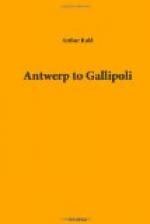Both he and the officer at my left—a big, farmer-like commissary man— spoke most amiably of the Russians. The latter told of one place where both sides had to get water out of the same well. And there was no trouble. “No,” he said, in his deep voice, “they’re not hose,” using the same word “bad” one would apply to a naughty boy. They were a particularly chipper lot, these artillerymen, and when I told the young lieutenant, who had been assigned to speak French to me under the notion that I was more at home in that language, that I had stopped at Queens Hotel instead of the St. Antoine in Antwerp, and that the Belgian army had crossed the Scheldt, and the pontoon bridge had been blown up directly in front of the hotel, he said that he would “certainly engage rooms there for the next bombardment,” as he waved good-by.
We were presented, while in Lemberg, to General Bom-Ermolli, and lunched at the headquarters mess. We also met Major-General Bardolf, his chief of staff, and chief of staff of the assassinated Crown Prince. The latter described to us the campaign about Lemberg, and it was interesting to hear the rasping accent he gave to a word like “Durchbrechung,” for instance, as if he were a Prussian instead of an Austrian, and to observe the frankness with which he ascribed the difference that had come over the spirit of the Austro-Hungarian army to the coming of Mackensen and the Germans.
West of Lemberg the pleasant country lost its war-time air and in Przemysl the two or three lonely Landsturm men guarding the wrecked fortifications, twice taken and twice blown up by retreating armies, lit candles to take us through the smashed galleries, and accepted a few Hellers when we came out, with quite the bored air of professional museum guides.
The town of Przemysl itself was untouched. The greater part of the visible damage to the forts, some distance outside the town, was done by the dynamite of the retreating army. In one place, however, we saw the crater of one of the 42-centimetre shells which have been talked about oftener than they have been used. The Austrian “thirty-point-fives” have done much of the smashing ascribed to the “forty-twos,” and ordinary work, like that of bombarding a city or infantry trenches, by cannon of smaller caliber. A genuine forty-two had been dropped here, however, we were told, on a building used by the Russians to store ammunition, and the building had simply disappeared. There was nothing left but a crater sixty or seventy feet across and eighteen to twenty feet deep.
We trailed westward, through Tarnow, where the great drive first broke through, and on to the pleasant old university city of Cracow on the frontier of the Poland of which it was once the capital, and to which it belonged until the partition of 1795. It was toward Cracow that the Russians were driving when they first started for Berlin, and they were but a stone’s throw away most of the winter.




